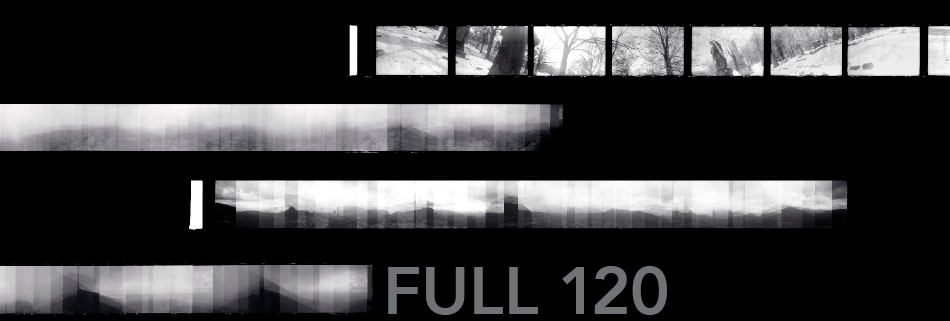
| Contact | |
In
the mid 1990s, I acquired a 1930s Adox folding camera designed to
make eight 6 x 9 cm frames
on a piece of 120 roll film. The camera proved to have certain
quirks—for example, significant light leaks through the back and a
distinct softness in the images resulting probably from the separation
over time of the glass lens elements. These made it impractical for
conventional use, but there was a certain melancholy feeling to the
flawed images it made that led me to continue experimenting with it. When I began these experiments, the digital revolution had emerged over the horizon, but conventional chemical photographic processes were still commonly used. In the context of the subsequent rampant proliferation of digital images, old-style chemical photography began to look more and more like just another form of print-making, with the negative analogous to the lithographic plate or woodblock. If you think of the negative as the plate, then eventually you note how each indivdual frame is in fact part of a bigger plate—the whole roll of film—which is composed over time as you expose it to light from one end to the other. The angle of view of the lens in this camera is 45 degrees (approximating the "normal" human binocular field of view). Forty-five degrees times 8 frames edge-to-edge is 360 degrees, so one roll of film works out to one complete spin. Clearly, a roll of 120 film has an inherent proportional relationship to human experience. So it was a natural idea to make contact prints from uncut rolls of film, with eight frames showing one 360-degree loop. Another feature of old cameras like this is that the film advance mechanism is completely manual—you look through a little red window on the back of the camera waiting for the next number to show up in order to align the next frame properly. This makes it possible to—accidentally or on purpose—advance the film small random amounts to make overlapping exposures. You can't predict exactly what will happen, buy you do know that, no matter what, the film will be a document (however fragmentary and inscrutable) of some movement through place and time. This approach produces a mash-up of concrete imagery and random abstract pattern, something to disquiet literalists and formalists alike. By the mid-2000s, the chemical photography industry had pretty much run aground, leading not only to the discontinuation of my favorite b&w films but to signficant difficulty getting paper upon which to print 6 x 80 centimeter images. Those factors, combined with the considerable challenges of getting consistent results contact printing from these long skinny negatives, encouraged a re-evaluation. In the end, I devised a way to scan the negatives without cutting them, which allows making digital prints that are the closest thing to a contact print from that whole roll of 120 film. The images here are made from those scanned negatives. ––———
Version 2.0 of this project—Place/Time—is fully digital and in color, but the same idea: the overlapping sequence of images, left to right, moves through a place over time. Sometimes it moves in a circle, sometimes along a path, maybe across an ocean. Occasionally, the world moves by the camera. Though the film itself has retired, the idea was born on film and thus the shape of the image remains that of a sheet of 120 roll film, 6 x 80 centimeters, the natural proportions of a good look around. |
|
|